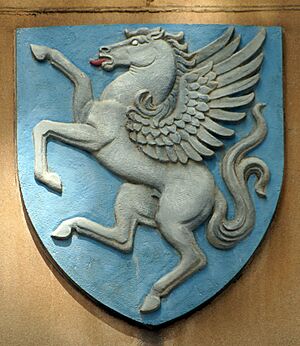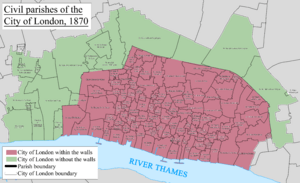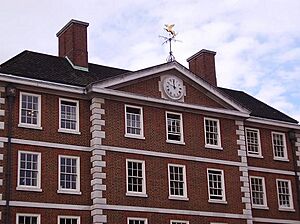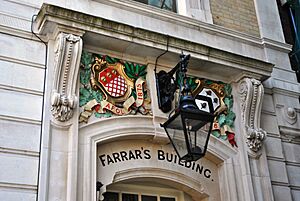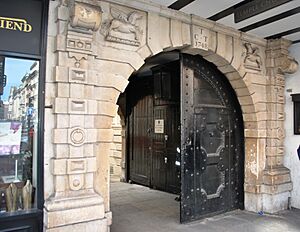Inner Temple facts for kids
The Inner Temple is one of four special places in London called Inns of Court. These Inns are like clubs or schools for barristers and judges. To become a barrister (a type of lawyer who speaks in court) in England and Wales, you must be a member of one of these Inns. The Inner Temple is located in an area called the Temple, close to the Royal Courts of Justice in the City of London. It acts almost like its own small, independent town!
The Inner Temple helps train lawyers and makes sure they follow the rules. It's run by a group called "Parliament," made up of senior members called "Benchers." The leader is the "Treasurer," who serves for one year. The name "Temple" comes from the Knights Templar, who used to own this land a long, long time ago, until 1312. The Inner Temple has been a separate group since at least 1388. After a tough start (it was almost completely destroyed in the Peasants' Revolt), it grew to be the second-largest Inn during the time of Queen Elizabeth I.
The Inner Temple grew even more under King James I and King Charles I, with many students joining. But the First English Civil War stopped all legal training for nearly four years. After the war, when King Charles II returned to London, the Inner Templars welcomed him with a huge party!
After a quiet period in the 1700s, the Temple became busy again in the 1800s, with new buildings like the Hall and Library. Sadly, much of it was destroyed during World War II bombings. Rebuilding finished in 1959. Today, the Inner Temple is still a very active Inn of Court, with over 8,000 members.
Contents
What the Inner Temple Does
The Inner Temple is one of four Inns of Court. The others are Gray's Inn, Lincoln's Inn, and the Middle Temple. These Inns are in charge of training and guiding barristers in England and Wales. They are the only groups that can officially allow a person to become a barrister and work in court.
The Inner Temple is an independent group. It has about 8,000 members, and around 450 people apply to join each year. In the past, the Inn did all the training and discipline itself. Now, these jobs are shared among the four Inns. A group called the Bar Standards Board handles discipline, and the Inns of Court and Bar Educational Trust helps with education.
History of the Inner Temple
Knights Templar and the Beginning
The story of the Inner Temple starts in the 1100s. The Knights Templar, a famous group of knights, moved their London home from Holborn to a new spot by the River Thames. This land stretched from Fleet Street to what is now Essex House. The Knights even built a new street, now called Chancery Lane, to reach their buildings.
In the 1200s, the first lawyers came to live here. They were legal helpers for the Knights. But the Knights Templar lost favor and their group was closed down in 1312. The king took their land and later gave it to another group, the Knights Hospitaller. The Hospitallers probably didn't live there. They rented out the land to make money.
Two groups of lawyers began renting parts of the land. They became known as the "inner inn" and the "middle inn." These groups grew into the Inner Temple and the Middle Temple. By 1388, they were separate societies. The Hospitallers rented the land to the Inner Temple for £10 a year.
Early Challenges
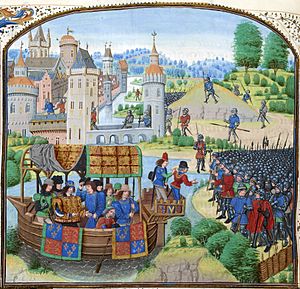
We don't have many records from the Inner Temple's early years (1300s and 1400s). In 1381, during the Peasants' Revolt, rebels led by Wat Tyler attacked the Temple. They pulled down buildings and burned records. A writer named John Stow said the rebels "went to the Temple to destroy it." They burned "all the books and remembrances" of the law students.
After the attack, the people living there took the chance to rebuild much of the Temple. It's thought that the Temple's main Hall was built around this time. The Inns of Court were also attacked during Jack Cade's Rebellion, but there are no specific records of damage to the Inner Temple.
Later, in 1539, the king took over the Hospitallers' properties. The Inner and Middle Temples then rented the land from the king. In 1608, King James I officially gave the land to a group of important lawyers from the Inner and Middle Temples. They had to pay him £10 a year each.
Elizabethan Times
During the time of Queen Elizabeth I, the Temple was greatly improved. It had over 100 sets of rooms for lawyers and was the second-largest Inn. In 1574, there were 155 students living there.
In the winter of 1561, the Inner Temple held amazing parties called "revels." They celebrated making Robert Dudley their "Christmas Prince." They did this because he helped them win an argument with the Middle Temple over some land. Queen Elizabeth I herself asked for the Inner Temple to win! Because of this, the Inner Temple promised never to take a case against Dudley and always offer him their legal help.
This promise was always kept. In 1576, the Inner Temple called Dudley their "chief governor."
The 1600s

The Inner Temple continued to grow in the early 1600s. Between 1600 and 1640, 1,700 students joined. But the First English Civil War stopped all legal training. The Inns were almost completely shut down for nearly four years.
After the war, when King Charles II returned to London, the Inner Temple held a huge party for him on August 15, 1661. The King, many Dukes, Earls, and Lords attended. They arrived by the King's boat, walked through the Temple Garden, and enjoyed a lavish feast. After this, the King's brother, the Duke of York, and other important people were made honorary members.
During the rule of the House of Stuart, rules were made to stop Catholics from becoming senior members of the Inner Temple. Only Protestants were chosen for important roles.
The Temple also showed its independence in 1668. The Lord Mayor of London tried to enter the Temple with his sword, which was allowed in the City but not inside the Temple. The students took his sword and made him stay the night! The King heard about it but decided the Temple could make its own rules about swords.
Much of the Inn was destroyed in the Great Fire of London in 1666. More fires in 1677 and 1678 caused a lot of damage too.
From the 1700s to Today
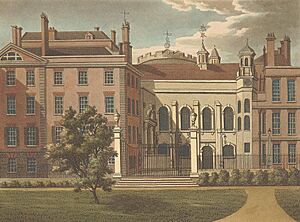
The 1700s were a quiet time for the Inner Temple. The buildings started to get old and worn out.
But in the 1800s, much of the Temple was rebuilt, especially the Hall and Library. In 1922, Ivy Williams became the first female barrister in England and Wales after being called to the bar by the Temple.
The Temple suffered greatly during World War II. Bombs hit it in 1940 and 1941, destroying the Library clocktower, the Hall, Temple Church, and many lawyers' offices. Fires burned for a whole day.
Rebuilding started after the war. The new buildings were finished in 1959. The Library, the last building to be completed, opened in 1958.
In 2001, the Inner Temple bought a nearby building, 1–2 Serjeant's Inn. It was planned for lawyers' offices, but it's now rented out as a hotel.
Structure and How It's Run
The Inner Temple is run by its "Parliament," which is a group of elected senior members called "Benchers." The leader of Parliament is the Treasurer, who is chosen each year. For 2023, the Treasurer is Sir Robert Francis KC. The Inner Temple also has a "Reader," who usually becomes the Treasurer the next year.
In the past, the Inner Temple was run by a Treasurer and three Governors. Now, the Benchers are in charge of the buildings, money, and rules. Today, there are about 350 Governing Benchers. There are also honorary Benchers, who are important people from law or other fields.
Coat of Arms
The Inner Temple's symbol, or coat of arms, is a "blue shield with a Pegasus leaping in silver." A Pegasus is a mythical winged horse. It's thought that the idea for the Pegasus came from the 1561 Christmas parties, where Robert Dudley played a character who was a patron of the "Order of the Pegasus." The symbol was officially confirmed in 1967.
A Special "Liberty"
The Inner Temple (along with the Middle Temple) is one of the few remaining "liberties." This is an old name for a special area that runs itself. It's like an independent neighborhood that isn't fully controlled by the City of London Corporation. It even has its own local government powers! So, while it's inside the City of London, it's also its own little area.
Silver and Pewter Collection
The Inner Temple has a valuable collection of silver and pewter items, like cups and dishes. The first mention of these items is from 1534. Over time, more pieces were added. One special item is a silver-gilt cup shaped like a melon, with feet made from the melon's "tendrils." It's a very prized possession.
A large part of the collection was stolen in 1643, but it's not known if it was found again. Records from 1703 show the Temple owned many cups, salt cellars, and spoons. They also bought a nef, which is a fancy ship-shaped table decoration.
Buildings of the Inner Temple
The Inner Temple has many buildings, some old and some new. Only Temple Church remains from the time of the Knights Templar.
Barristers' Offices (Chambers)
The Inn has several buildings where barristers have their offices, called "chambers." The rooms above the second floor are usually homes. Some of these buildings are Crown Office Row, Farrar's Building, Hare Court, King's Bench Walk, and Paper Buildings.
- Crown Office Row was named after an old office that used to be there. The current buildings were designed by Sir Edward Maufe. The famous writer Charles Lamb was born in one of these buildings, which was destroyed in World War II.
- Hare Court was named after Nicholas Hare, who built the first offices there in 1567. A fire in 1678 destroyed parts of it. The court has a pump whose water was known for being very pure in the 1800s.
- King's Bench Walk has had buildings since at least 1543. These were burned down in the Great Fire of London and other fires. The buildings are named after the King's Bench court office that used to be there.
- Paper Buildings are on the site of older buildings from 1610. They were called "paper" buildings because they were built with wood, lath, and plaster, a light construction method. A fire in 1838 destroyed some of them. The famous lawyer John Selden lived here.
Gardens and Gateway
The Inner Temple Gardens were created around 1601. They have special iron gates from 1730 with the Temple's Pegasus and the griffin of Gray's Inn, showing their friendship. The gardens have a sundial from 1707 and a statue of a blackmoor. A rookery (a place where crows live) was started here in the 1700s. The gardens were once famous for their roses, and William Shakespeare even wrote that the Wars of the Roses started in the Inner Temple Garden!
The Gateway, at the top of Inner Temple Lane on Fleet Street, has been in the same spot since the Knights Templar first built it. It was rebuilt in 1610 and again in 1748. The building above the gateway is said to have been the council rooms for Henry Frederick, Prince of Wales and King Charles I.
The Hall
The original Hall of the Knights Templar was replaced in the 1300s or 1400s. It was repaired many times but was in bad shape by 1816. It was finally torn down in 1868.
A new, larger Hall was built in the Gothic style and opened in 1870. It was 94 feet long and 40 feet high. Its glass windows showed the symbols of important Treasurers from the 1500s onwards.
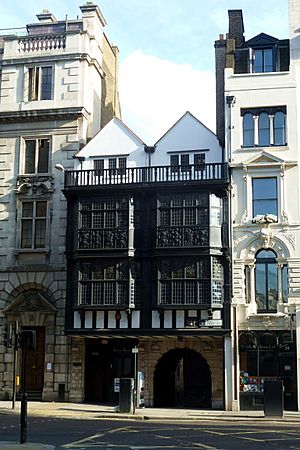
This Hall was destroyed during World War II. The foundation stone for the new Hall was laid by Queen Elizabeth II in 1952. The building opened in 1955.
The Library
The first Library existed from at least 1506. It was a single room, also used for dining and practice trials. By 1607, a second room was added. The Library of the Inner Temple was much better than those of the other Inns of Court.
In 1654, the Library refused to accept John Selden's huge collection of manuscripts. This was a big loss for the Library. The Library was completely destroyed in the Great Fire of London in 1666, but a new one was built in 1668. A smaller fire in 1679 caused one library building to be torn down to stop the fire from spreading.
In 1707, the Inner Temple was given money to build a new Library, which was finished in 1709. It had three rooms. A Librarian was hired right away, a practice that continues today. The Library was expanded several times in the 1800s. By 1882, it had 26,000 law books and 36,000 history books.
This building was also destroyed during World War II. Although some rare books were moved to safety, 45,000 books were lost. A new Library was built in 1958 and now holds about 70,000 books.
Temple Church
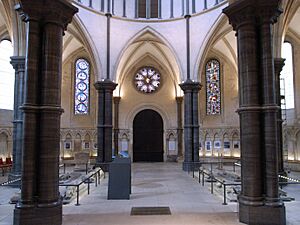
Temple Church is known as one of the best round churches still in London. The original round part was built in 1185 by the Knights Templar. Many important people were buried there.
After the Templars, the church went to the Knights Hospitaller, and then to Henry VIII. King James I gave the Inner and Middle Temples their independence, but only if they promised to take care of the church. They still do this today. Both societies also own the Master's House next to the church, built in 1764.
Over the years, the church had many repairs and changes. But on May 10, 1941, during World War II, firebombs completely burned out the inside of the church. It was restored over the next ten years and reopened in 1954.
Famous Members
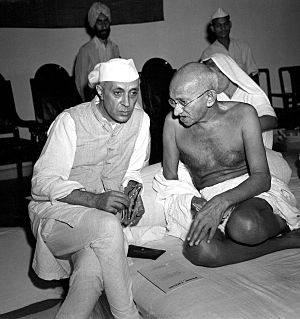
Many important judges have been members, like Sir Edward Coke and Lady Justice Butler-Sloss.
Several famous politicians and leaders from around the world also studied law at the Inner Temple:
- Jawaharlal Nehru, the first Prime Minister of India.
- Mahatma Gandhi, a leader of India's independence movement.
- Liaquat Ali Khan, the first Prime Minister of Pakistan.
- Clement Attlee, a British Prime Minister.
- Tunku Abdul Rahman, the first Prime Minister of Malaysia.
- Fakhruddin Ali Ahmed, the fifth President of India.
- S. W. R. D. Bandaranaike, the fourth Prime Minister of Ceylon.
- King Jigme Khesar Namgyel Wangchuck of Bhutan.
Other famous members include:
- The explorer Francis Drake.
- The writer W. S. Gilbert.
- The economist John Maynard Keynes.
See also
 In Spanish: Inner Temple para niños
In Spanish: Inner Temple para niños
- Thomas Joshua Platt
Images for kids
-
The Inner Temple after the Fire of 1737 by Richard Wilson



